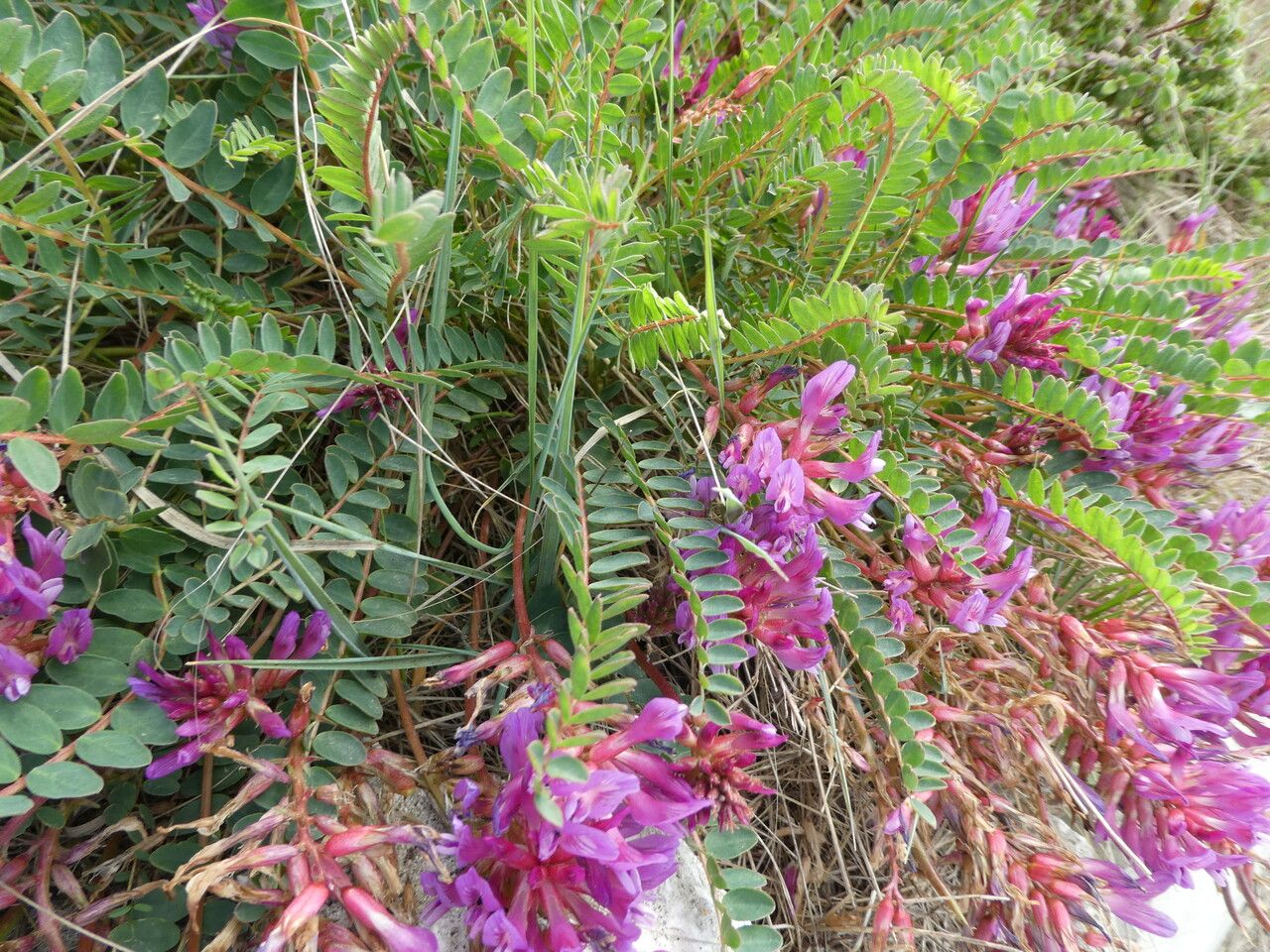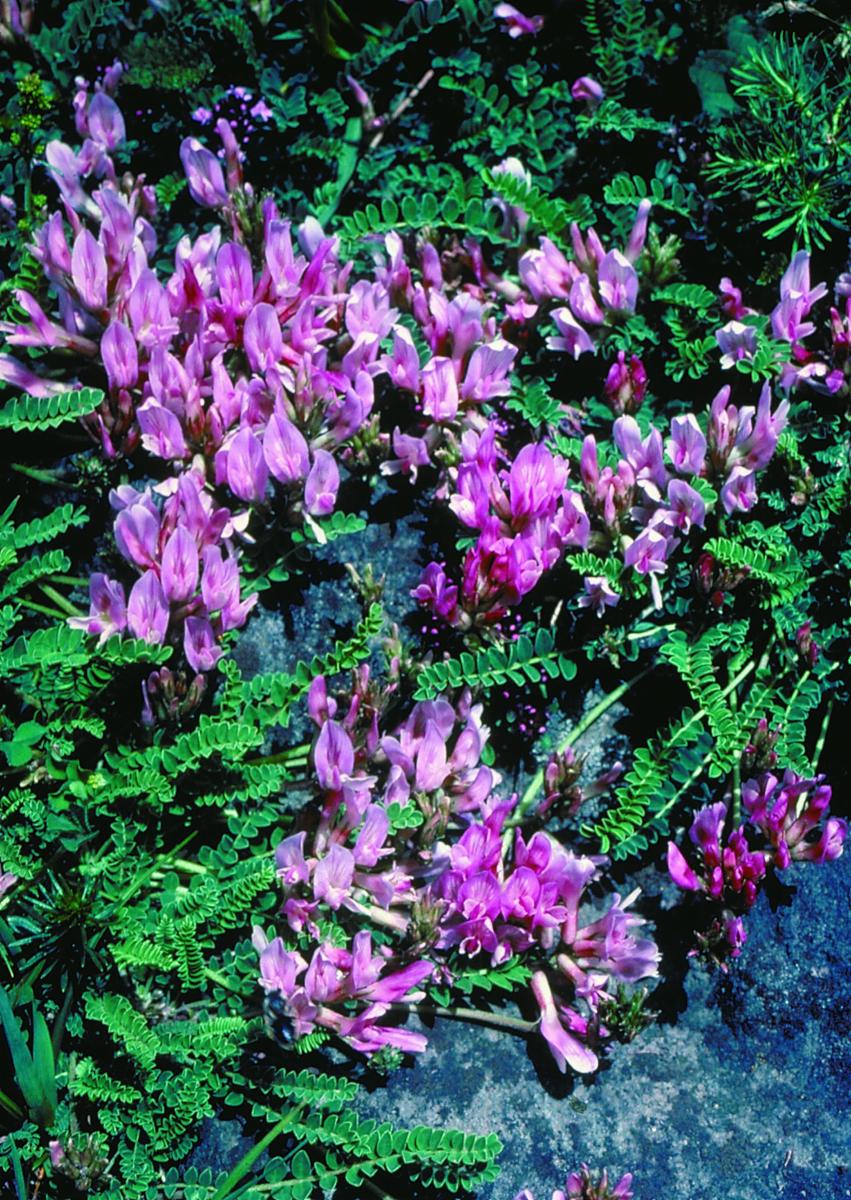Mediterranean milkvetch
astragalus monspessulanus
Also known as: ["Milkvetch","Goat's-thorn"]
Overview
A perennial herbaceous plant native to the Mediterranean region, known for its pea-like flowers and pinnate leaves.
Benefits & Perks
["wildlife attractant (bees, butterflies, birds)","drought tolerant","aesthetic foliage"]
Botanical Classification
| Phylum: | Magnoliophyta |
| Class: | Magnoliopsida |
| Order: | Fabales |
| Family: | Fabaceae |
| Genus: | Astragalus |
| Botanical Name: | Astragalus monspessulanus |
Plant Characteristics
Basic Information
- Category: Flowers
- Suitable Location: rock garden, border, or container in a sunny spot
- Suitable For:
- Is Weed: No
- Allergenicity: low
Environmental Needs
- Climate: {"temperatureRange":"5–30°C"}
- Hardiness: {"zones":"6–9"}
- Misting: rarely required, only if ambient humidity is very low
- Drainage: Fast-draining to prevent waterlogging.
- Soil Type: Well-draining, loamy soil with added organic matter; suitable for rocky or sandy conditions.
Maintenance Level
- Maintenance Level: moderate
- Toughness Level: moderate
- Pruning Frequency: Annually in late winter or early spring; light pruning can be done as needed.
- Pruning Intensity: Moderate; remove up to one-third of the plant if necessary to rejuvenate growth.
Care Details
Ideal Sunlight Coverage:
Full sun to partial shade; 6–8 hours of direct sunlight per day, with some afternoon shade in hot climates.
Sunlight Tolerance Tips:
Acclimate plants gradually to intense sunlight; protect from harsh midday sun; adjust placement based on seasonal light changes.
Care Requirements
Care Difficulty
moderatemoderate
Sunlight
full sun to partial shade
Rotate plant for even light exposure; use shade cloth in extreme heat; monitor for sunburn.
Watering
every 7–10 days during active growth, reduce in winter
Water thoroughly but infrequently; ensure soil dries between waterings; avoid overwatering.
Soil
well-drained, sandy loam with moderate organic content
pH: Slightly alkaline to neutral, pH 6.5–7.5.
Use a mix of garden soil, sand, and compost; avoid heavy clay soils; ensure pots have drainage holes.
Temperature
Prefers moderate temperatures, 60–75°F (15–24°C); tolerates mild frosts but avoid prolonged cold.
Protect from frost; avoid sudden temperature swings; maintain consistent warmth during active growth.
Fertilizing
every 4–6 weeks during spring and summer
Fertilize in spring and summer; dilute fertilizer to prevent burn; stop in fall and winter.
Propagation
Methods
Stem cuttings or division; stem cuttings are more common for home growers.
Step-by-Step Propagation Guide
- Take a 4–6 inch cutting.
- Remove lower leaves.
- Apply rooting hormone.
- Plant in medium.
- Keep moist and warm.
Best Time: Spring or early summer when the plant is actively growing.
Environment
Warm, humid environment with indirect light; maintain consistent moisture.
Medium
Well-draining potting mix, such as a mix of peat, perlite, and sand.
Hormone
Rooting hormone is recommended to improve success rates.
Timeline
Roots may develop in 3–6 weeks; new growth may appear in 2–3 months.
Tools Needed
Pruning shears, rooting hormone, small pots, well-draining medium.
Quick Tips
Use healthy, non-flowering stems; keep cuttings out of direct sun; maintain humidity with a plastic cover.
Pruning & Repotting
Pruning Guide
Method
Use clean, sharp tools; make cuts just above a leaf node or bud; avoid cutting into old wood.
Pruning Plan
Prune to maintain shape, encourage bushier growth, and remove dead or diseased parts.
Tools
Pruning shears, sterilizing solution, gloves.
Checklist
Sterilize tools; prune dead or damaged growth; shape the plant; clean up debris.
Repotting Guide
Best Season
Spring, before the active growing season begins.
Pot Size
Choose a pot one size larger than the current one; ensure good drainage.
Method
Remove plant gently; trim roots if needed; place in a new pot with fresh soil; water lightly.
Suggestions
Repot every 2–3 years or when roots fill the pot; beneficial for growth and health.
Checklist
Select appropriate pot; prepare new soil mix; handle roots carefully; water after repotting.
Advanced Care Tips
Watering Mastery
Watering Checklist
Check soil moisture; water deeply; ensure drainage; adjust for season.
How to Apply Water Properly
Water at the base of the plant, ensuring moisture reaches the root zone; allow excess water to drain away; water in the morning to reduce evaporation.
Watering Schedule Tips
Water deeply once the top inch of soil feels dry; reduce frequency in winter to prevent root rot.
Soil Improvement
Add perlite or sand for drainage; incorporate compost for fertility; ensure good aeration.
Temperature Stress Management
Signs of Temperature Issues
Wilting, leaf drop, or stunted growth in cold; scorching or leaf curl in excessive heat.
Cold Stress
Slows growth, may cause leaf discoloration, and increases susceptibility to root rot.
Solution: Move to a warmer location; provide frost protection; reduce watering in cold periods.
Hot Stress
Leaves may scorch, growth may slow, and water demand increases.
Solution: Provide shade during peak heat; increase watering; ensure good air circulation.
Fertilizing Guide
Fertilizing Checklist
Check fertilizer type; dilute properly; apply during growing season; avoid winter feeding.
Fertilizing Method
Use a balanced, water-soluble fertilizer diluted to half strength every 4–6 weeks during the growing season; avoid fertilizing in winter.
Common Problems & Solutions
Toxicity Warning
Cats
Slightly ToxicAstragalus monspessulanus is considered slightly toxic to cats. Similar to dogs, the toxicity is associated with the ingestion of seeds and roots, which may contain compounds like selenium or nitrates that can lead to gastrointestinal upset or other adverse effects in cats.
⚠️ Symptoms:
🌿 Toxic Parts:
⚡ Toxic If:
if ingested in large quantities
Dogs
Slightly ToxicAstragalus monspessulanus is considered slightly toxic to dogs. The toxicity arises primarily from the ingestion of seeds and roots, which may contain compounds like selenium or nitrates that can cause gastrointestinal distress or other systemic effects in dogs.
⚠️ Symptoms:
🌿 Toxic Parts:
⚡ Toxic If:
if ingested in large quantities
Humans
Non-toxicAstragalus monspessulanus is typically non-toxic to humans. However, certain strains may contain toxic compounds such as selenium or nitrate accumulations, which can lead to poisoning if ingested in large quantities. The physiological impact is minimal under normal conditions.
⚠️ Symptoms:
🌿 Toxic Parts:
⚡ Toxic If:
Generally non-toxic unless specific strains contain toxic compounds
Frequently Asked Questions
Q: Is Astragalus monspessulanus toxic to pets?
A: There is insufficient data to confirm its toxicity to pets.
Q: How often should I water this plant?
A: Water moderately, allowing the soil to dry slightly between waterings.
Q: Does this plant attract wildlife?
A: Yes, it attracts bees, butterflies, and birds due to its nectar-rich flowers.
Quick Reference
| Family: | Fabaceae |
| Care: | moderate |
| Light: | full sun to partial shade |
| Water: | every 7–10 days during activ |
Get Expert Care Tips
Download the Plantious app for personalized care reminders and plant identification!
Google Play App Store







